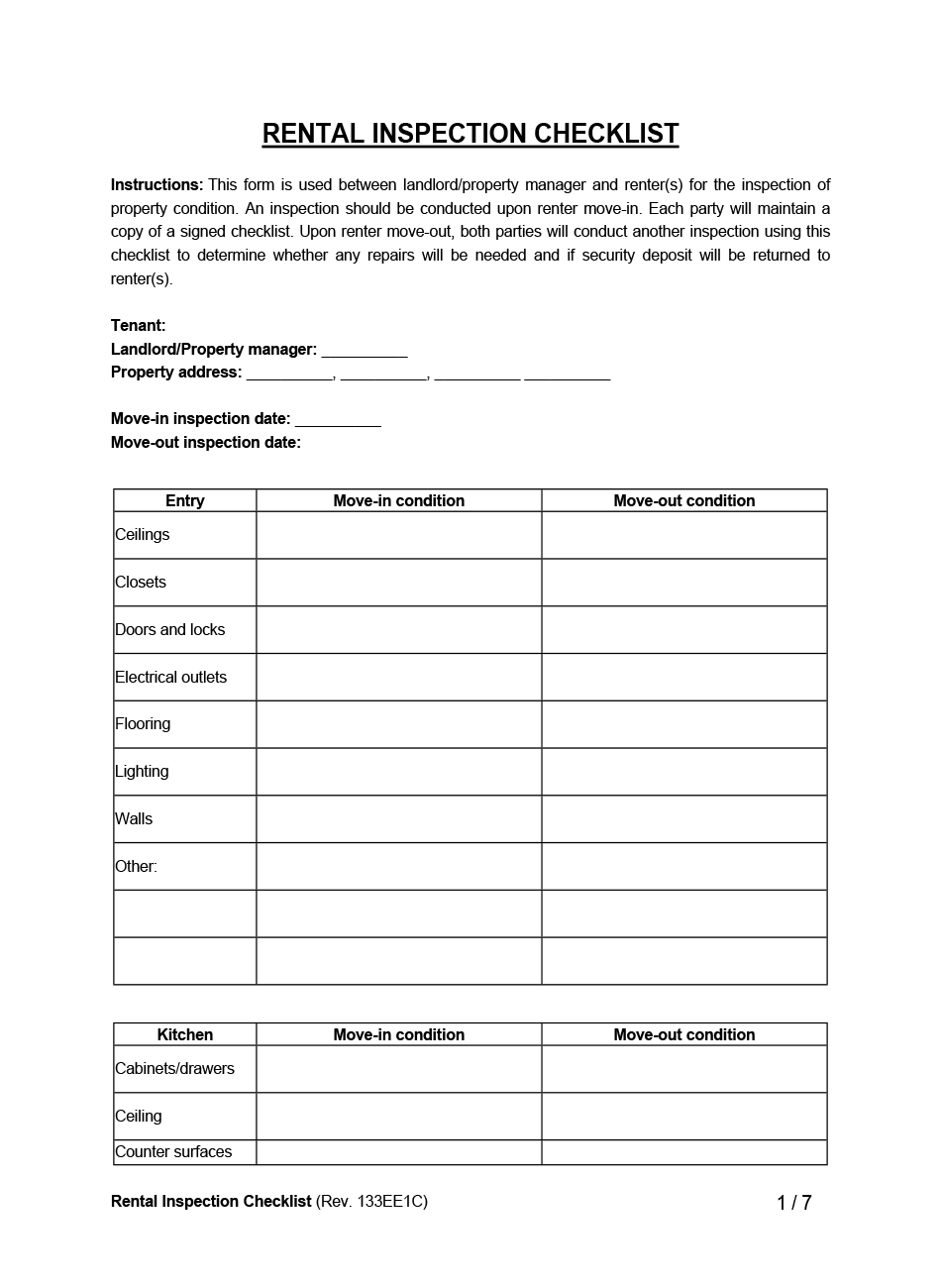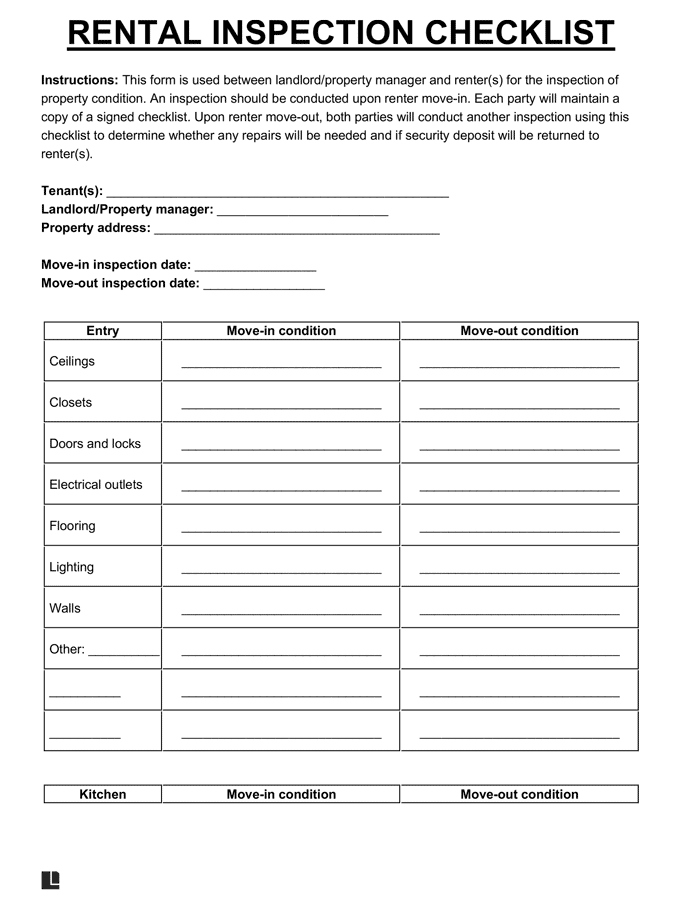A rental inspection checklist is an essential tool for landlords, property managers, and tenants, designed to systematically evaluate the condition of a rental property at various stages of tenancy: during move-in, periodically throughout the tenancy, and at move-out.
This ensures that all aspects of the property are carefully inspected, offering an opportunity to report any issues in each room of your rental. It helps identify maintenance issues, ensures compliance with lease terms, and protects the property’s value.
A rental inspection checklist should include the following:
General information:
- Move-in/Move-out dates: These dates are important to record to ensure a fair assessment of the property condition at the start and end of the lease.
- Tenant and property manager’s/landlord’s contact details: To facilitate open and easy communication.
- Emergency contact information: In case of emergencies, having contact is crucial for a quick response.
Exterior Inspection:
- Grounds: Check the general condition of the lawns, gardens, and any outdoor features such as pools or patios.
- Building Structure: Look for any signs of damage, like cracks, leaks, or areas that need painting.
- Roof and gutters: These should be in good repair and clear of debris.
- Windows and Doors: Check for cracks, proper operation, good sealing, and secure locks.
- Garage/Storage areas: These should be clean and secure.
Interior Inspection:
- Walls, Ceilings, and Floors: Check for damage such as holes, cracks, water stains, or marks.
- Windows: Ensure that they open and close properly and that the seals, locks, and screens are intact.
- Doors: Check for proper operation and secure locks.
- Lighting: Make sure all lights are functional.
- Ventilation and heating systems: Check that they’re operational and well-maintained.
- Smoke and Carbon Monoxide Detectors: Make sure these are functional and up to code.
Kitchen Inspection:
- Appliances: Check that all appliances are clean, functional, and in good repair.
- Cabinets and Countertops: Look for damage and ensure doors and drawers open and close properly.
Bathroom Inspection:
- Plumbing: Check for leaks, ensure hot and cold water supply, and check that toilets flush properly.
- Shower/Tub: Look for signs of mold or leaks.
- Cabinets and Countertops: Check for damage or issues with operation.
Miscellaneous:
- Pest Control: Check for signs of pests.
- Cleanliness: Overall cleanliness can be indicative of how well the property is being maintained.
- Damage: Record any damage, especially compared to the condition noted at move-in.
- Personal Belongings: Note any personal items left behind by previous tenants.
How to Conduct a Rental Inspection
Here’s a step-by-step guide on how to conduct a thorough rental inspection:
-
Before the Inspection:
- Schedule the Inspection: Coordinate with the tenant to find a suitable time for the inspection.
- Prepare the Checklist: Review all areas of the property. Include sections for each room, noting specific items like walls, floors, windows, appliances, and fixtures.
- Review the Lease Agreement: Familiarize yourself with the terms and conditions related to property maintenance and tenant responsibilities. Understand what constitutes normal wear and tear versus tenant-caused damage.
-
During the Inspection:
- Be Respectful: Approach the inspection with professionalism and respect for the tenant’s privacy. Explain the purpose of the inspection and what it entails.
- Communicate Clearly: Discuss any immediate concerns or issues with the tenant during the inspection. Ensure both parties are on the same page regarding the property’s condition.
- Document Everything: Take detailed notes on the condition of each area and item in the checklist.
-
After the Inspection:
- Create an Inspection Report: Compile the notes and photographs into a detailed inspection report. Include descriptions of any damages or maintenance issues observed.
- Discuss Necessary Repairs or Actions: Review the inspection report with the tenant. Clearly outline who is responsible for each repair, referencing the lease agreement as needed.
- Follow Up on Repairs: Schedule and oversee any required maintenance or repairs promptly. Document the completion of repairs and update the inspection report accordingly.
When Should You Require a Rental Checklist?
While tenants should be prepared to complete a rental inspection checklist upon signing the lease agreement and entering their new rental, it’s important to note that the process can vary depending on your state’s laws. In some instances, the landlord is required to provide a record of the property’s condition, including any existing damage or both parties complete jointly.
As the landlord or property manager, your responsibilities include:
- Verify Your Tenant’s Findings: Carefully review the checklist to ensure all reported issues are documented accurately.
- Sign Off on the Checklist: Sign the checklist to acknowledge and agree to the documented condition of the property.
- Begin Scheduling for Repairs: Address any issues that require immediate attention to maintain the property’s condition.
In addition to logging noticeable damages and defects, it is always advisable to photograph each issue. These photographs provide visual evidence that can be referenced later if disputes arise.
Once a tenant vacates your rental, reference your original copy of the rental checklist and determine if the tenant caused excessive damage during their tenancy.
Move-Out Condition Documentation
It is crucial for both landlords and tenants to document the move-out condition as well. This documentation helps ensure that tenants can receive their security deposits back. Here’s the process if damages occur:
- Move-Out Inspection: Conduct a thorough inspection when the tenant moves out, comparing the current condition to the initial move-in checklist.
- Photograph and Document: Take photographs and document any new damages beyond normal wear and tear.
- Determine Responsibility: Assess whether any damages fall outside the definition of normal wear and tear.
Security Deposit Process
- Normal Wear and Tear: Light damage resulting from normal wear and tear is always the landlord’s financial responsibility.
- Excessive Damage: Property owners should deduct the cost of any repairs that fall outside of that definition from the previous tenant’s security deposit.
- Returning the Security Deposit: After accounting for any deductions, return the remaining security deposit to the tenant within the time frame required by state law.
Legal Requirements
Some states require the landlord to provide the tenant with a move-in form or checklist. Even if it is not legally required in your state, it is still prudent to use one to avoid potential disputes and ensure clarity. Having a friend present during the inspection can be helpful. Their observations can serve as additional documentation in case of future disagreements.
Below is a table summarizing the move-in/move-out checklist requirements by state:
| State | Name of Form | Conditions | Statute |
|---|---|---|---|
| Arizona | Move-In / Move-Out Condition Checklist |
None | § 33-1321(C) |
| Arkansas | Move-In Inspection Form | None | § 18-17-502 |
| Georgia | Move-In / Move-Out Condition Report | Only if a security deposit is collected | § 44-7-33 |
| Hawaii | Property Condition Form | None | § 521-42(a) |
| Kansas | Inventory and Condition of the Premises | None | § 58-2548 |
Why Are Rental Inspections Important?
Ensuring that a rental property remains in excellent condition is a top priority for any landlord. Here’s where the rental inspection becomes a valuable tool. It helps you achieve the following key objectives:
- Avoid Future Disputes: Documenting the unit’s condition at various stages helps prevent conflicts with your tenant by providing clear evidence of any changes.
- Ensure Safety and Comfort: Identifying and addressing issues early ensures a safer and more pleasant living environment for your tenants, which can lead to longer tenancy and reduced turnover.
- Track Property Condition: Using a rental checklist helps maintain the property in good condition, which benefits both the landlord and the tenant.
- Assign Responsibility: A checklist helps track the liability of all incoming and outgoing tenants, making it clear who is responsible for any damages.
For tenants preparing to move, consider using a moving checklist to ensure all aspects of your relocation are covered. This can help you avoid missing critical steps and ensure a smooth transition to your new home.
How to Write a Rental Inspection Checklist
Step 1 – Write the Tenant and Landlord’s Name and Property Address
1. Tenant. Provide the tenant’s full name and the person renting the property from the landlord or property manager. If there is more than one tenant, provide the names of all tenants.
2. Landlord. Enter the full name of the landlord or property manager, the person who owns or manages the property.
3. Property Address. Fill in the street (physical) address of the rental property.

Step 2 – Enter Move-In or Move-Out Date
4. Move-In Inspection Date. Write the date you are conducting the move-in inspection.
5. Move-Out Inspection Date. Fill in the date you are conducting the move-out inspection.

Step 3 – Fill in the Entry Condition
6. Entry. Write the move-in or move-out condition of each area of the entry if the rental property has an entry area. You can write other portions of the entry not indicated on the checklist.
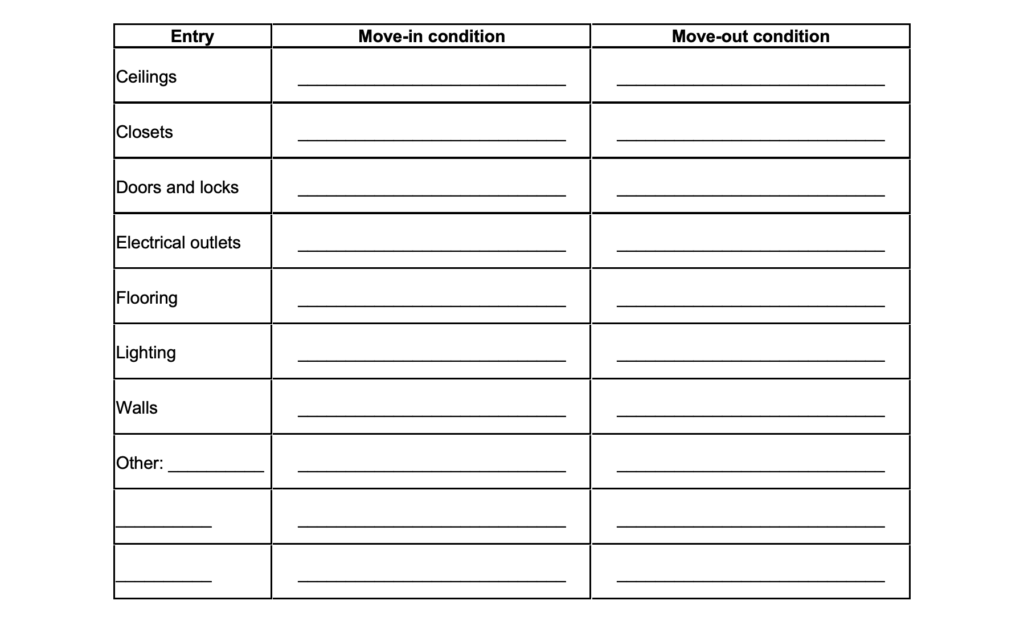
Step 4 – Document Kitchen Condition
7. Kitchen. State the move-in or move-out condition of each area of the kitchen if the rental property has a kitchen.

Step 5 – State Living Room Condition
8. Living Room. Specify the move-in or move-out condition of the living room if the rental property has a living room.
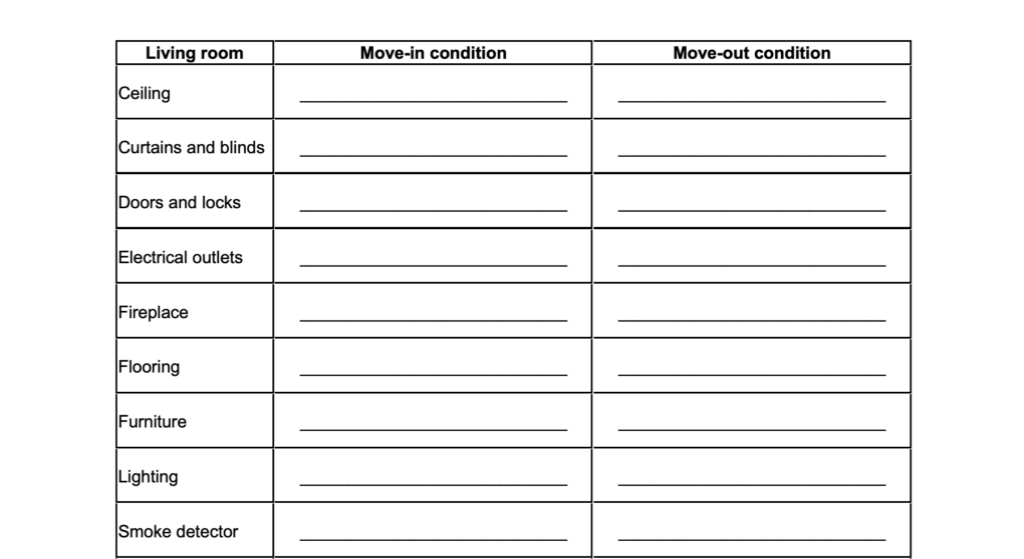
Step 6 – Fill in Dining Room Condition
9. Dining Room. Enter the move-in or move-out condition of the dining room if the rental property has a dining room.
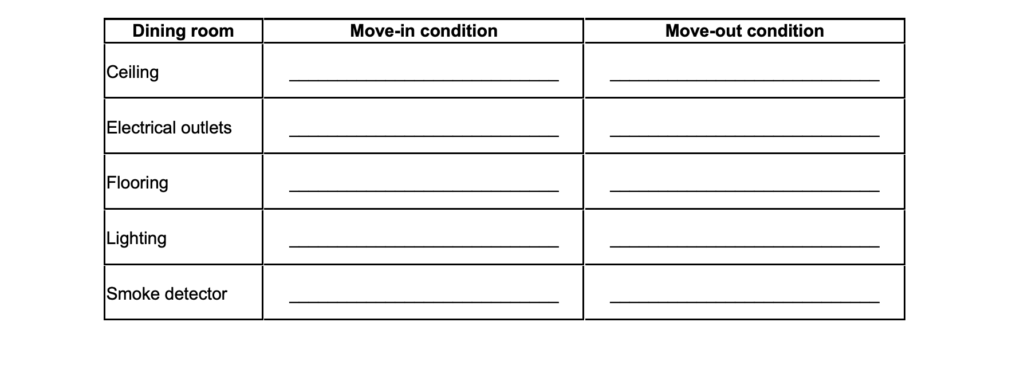
Step 7 – Note Bedroom 1 Condition
10. Bedroom 1. Fill in the move-in or move-out condition of the bedroom if the rental property has one bedroom.

Step 8 – Enter Bedroom 2 Condition
11. Bedroom 2. Write move-in or move-out the condition of a second bedroom if the rental property has a second bedroom. If the rental property has more than two bedrooms, you can add additional sections to the checklist.
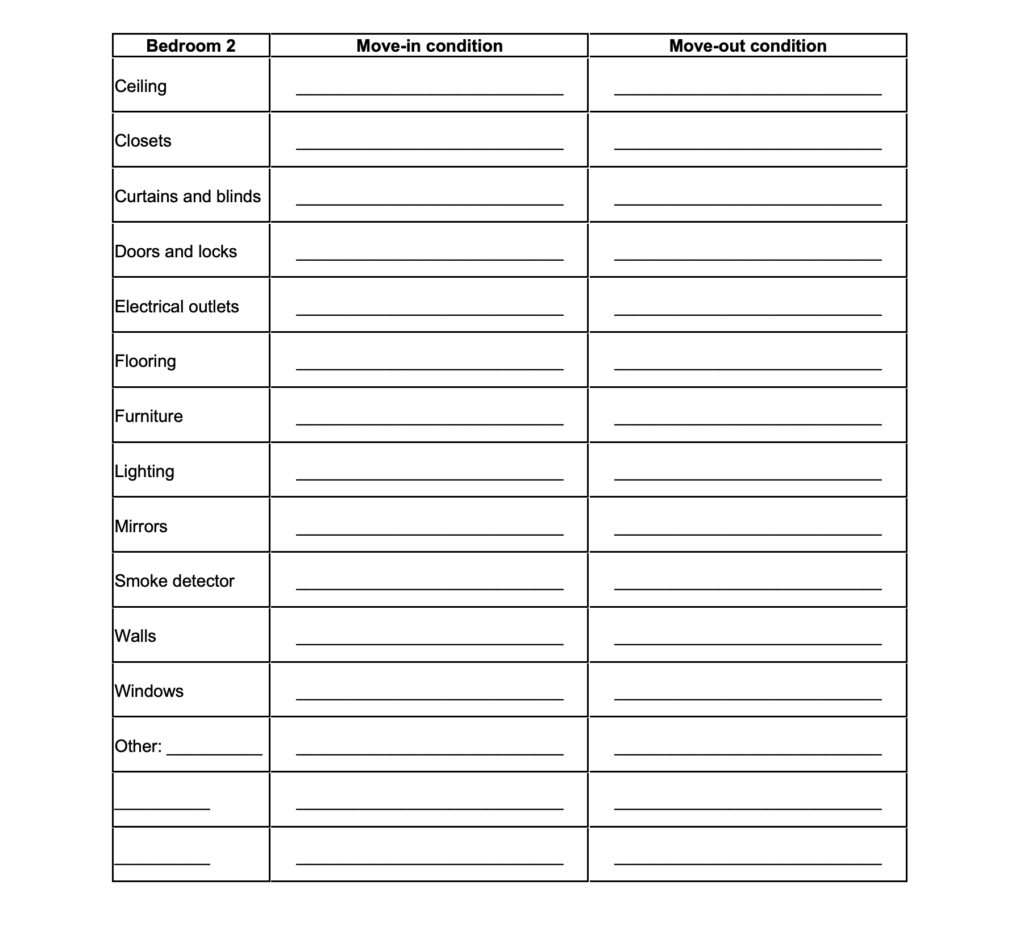
Step 9 – Note Bathroom 1 Condition
12. Bathroom 1. Document the move-in or move-out condition of the bathroom if the rental property has one bathroom.

Step 10 – Write Bathroom 2 Condition
13. Bathroom 2. Enter the move-in or move-out condition of a second bathroom if the rental property has a second bathroom. If the rental property has more than two bathrooms, you can add additional sections to the checklist.
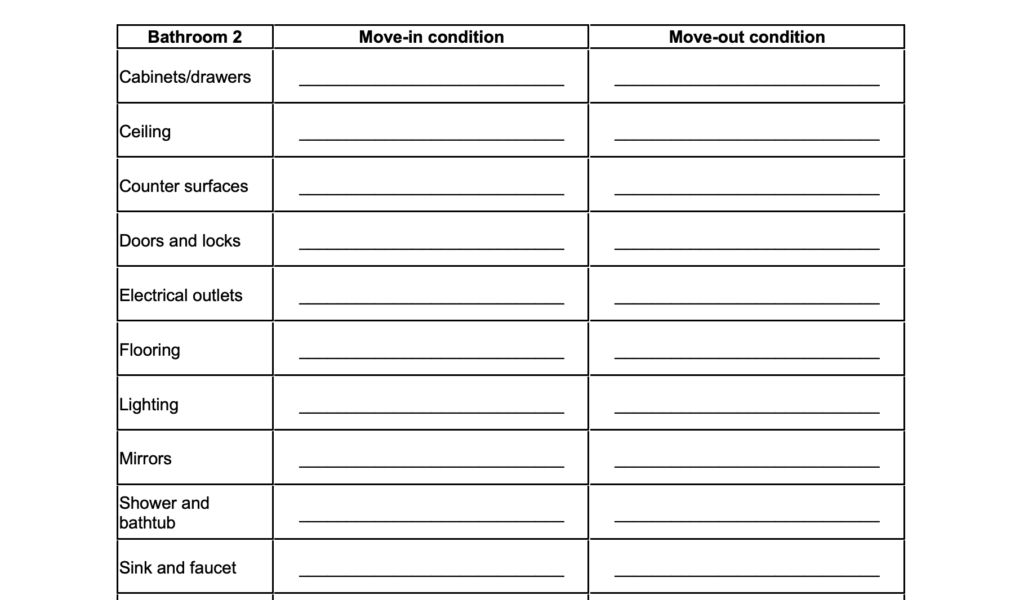
Step 11 – Document Garage Condition
14. Garage. Write the move-in or move-out condition of the garage if the rental property has a garage.
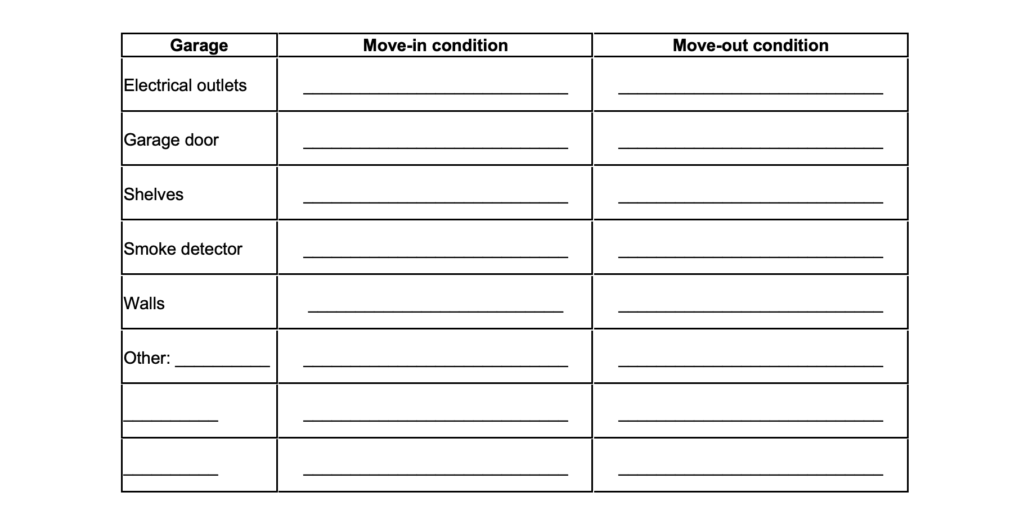
Step 12 – Fill in the Condition of Miscellaneous Areas
15. Miscellaneous. You can include the move-in or move-out condition of additional spaces in the rental property or items that have not been previously addressed.
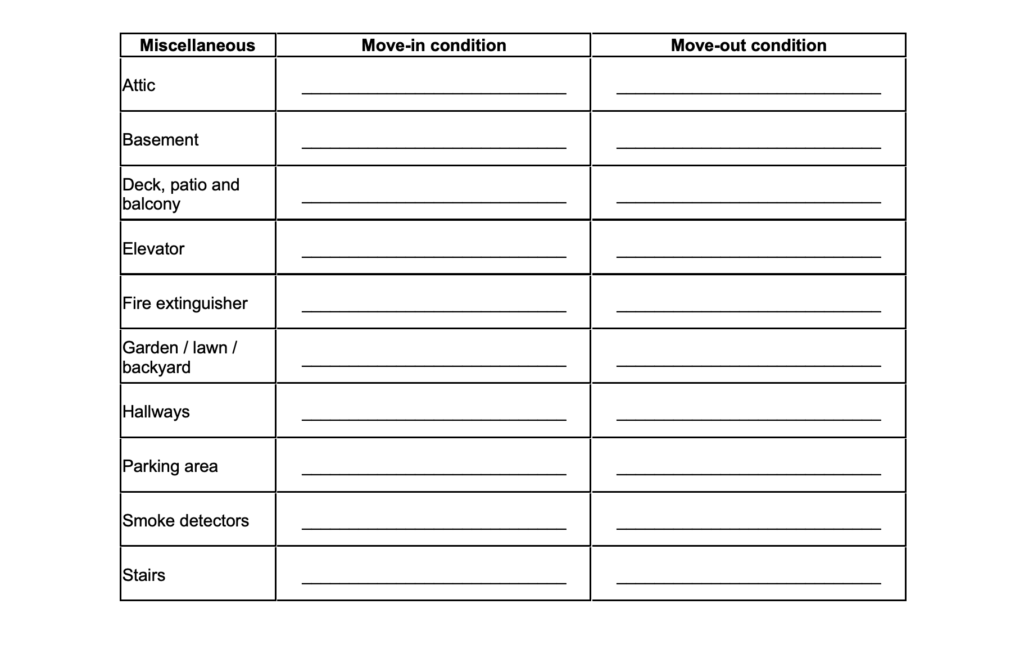
Step 13 – Enter Notes
16. Other Notes. You can include any additional notes as needed.

